Today, we’re talking about buttercream. Good old-fashioned perfect American buttercream frosting that most bakers know and love. If you’ve been struggling with your buttercream, this post is for you. Maybe you love to bake cakes, but you just can’t seem to get your buttercream quite right. You know that it’s not as good as it should be, but you’re not sure how to fix it. If your buttercream is too stiff, too sweet, too runny or too something, and you simply don’t know what to do to make it better, then you will love my recipe!
This is the best, most perfect American buttercream you’ll ever make, let me assure you. Today’s recipe is an informative post with lots to learn, so let’s get started!
Updated: I originally wrote this post in August 2012, and updated it in September 2022.
For more tips, be sure to read my post on How to Stack, Fill, Crumb Coat and Frost a Layer Cake.
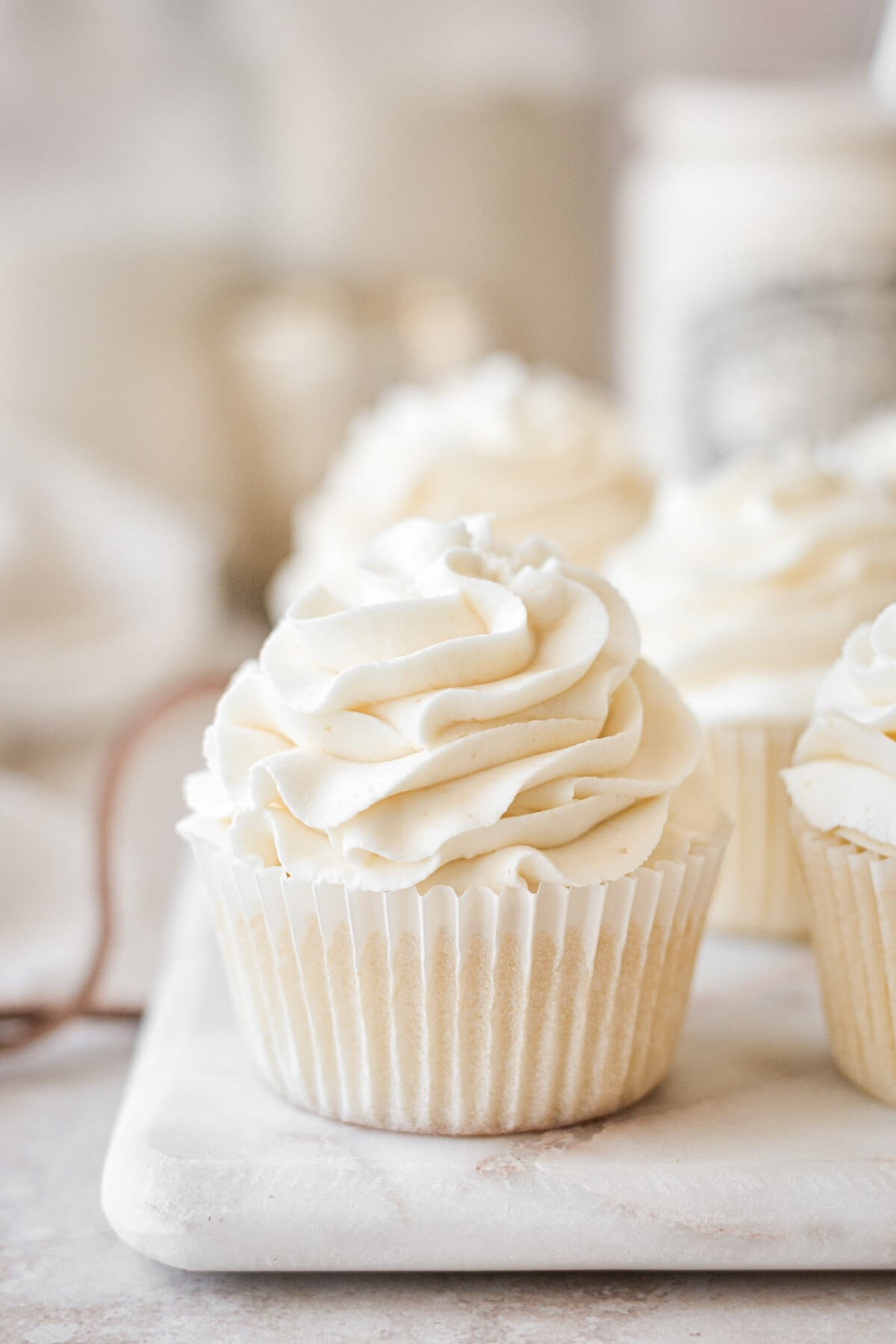
This site contains affiliate links. As an Amazon associate, I earn from qualifying purchases. This means that I may make a small commission if you purchase a product using those links. This in no way affects my opinion of those products and services. All opinions expressed on this site are my own.
Why You’ll Love This Buttercream
Not Too Sweet. Since my recipe uses about half as much powdered sugar as most recipes out there do, you’re not hit with an overwhelming sweetness when you eat one of my cakes. The frosting is rich and buttery, perfectly sweetened, and so fluffy.
Perfectly Pipeable. The texture is everything you want. Silky and smooth for frosting a cake with smooth sides, swirls or ripples, but also perfectly pipeable for any kind of elaborate piping you want to do.
Versatile. You can take this recipe and literally make any flavor of buttercream that you want. See the section below on all my suggested flavor variations.
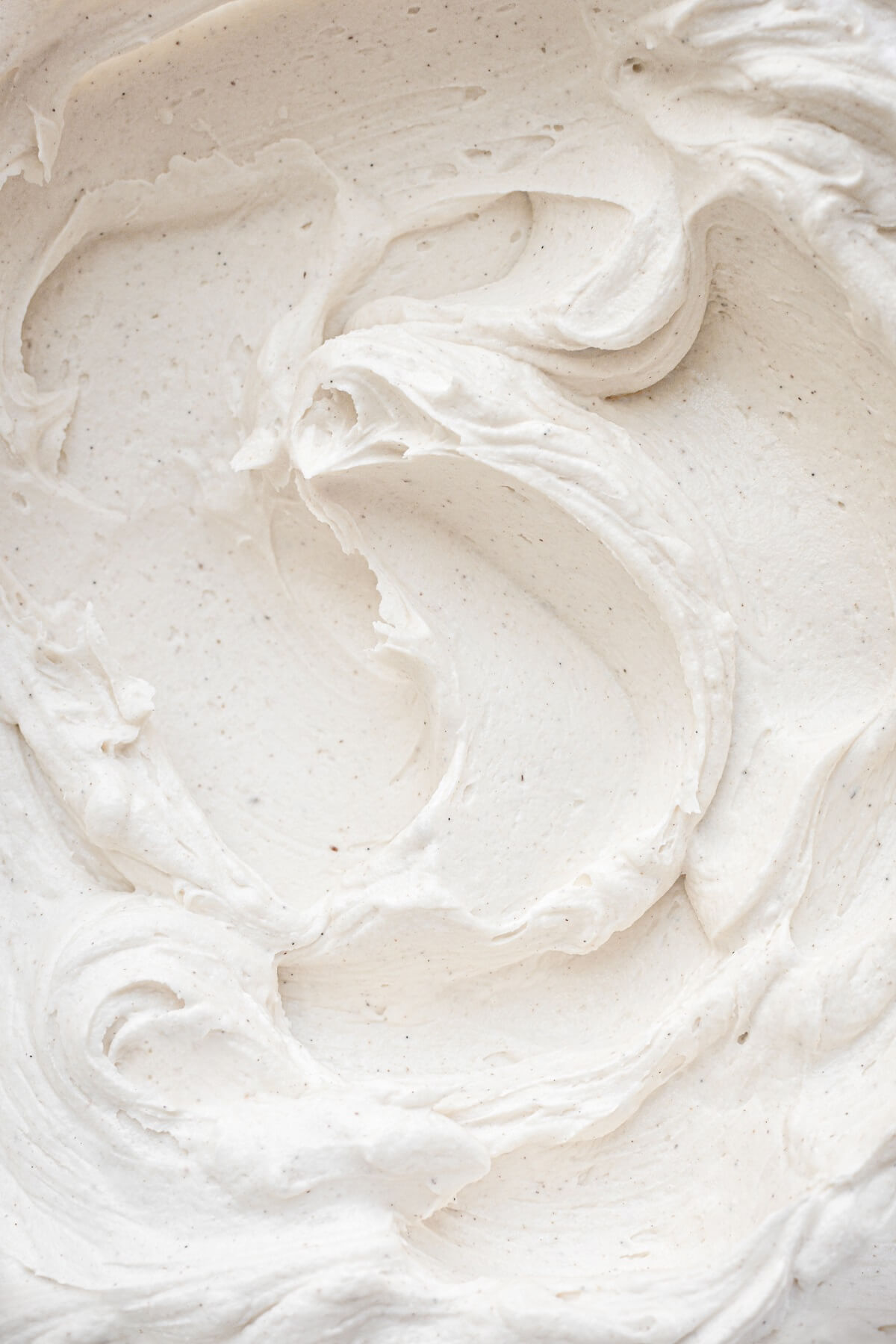
Today’s post is mainly about American buttercream, but there are many different types of buttercream that every baker should have at least a little knowledge of, and how they differ from each other.
Types of Buttercream
- American Buttercream Frosting. Made with butter and/or shortening, powdered sugar, vanilla extract and milk. It’s versatile, spreadable, can be tinted any color and flavored however you like. American buttercream is excellent for piping, and is very stable at room temperature. It’s considered a “crusting” buttercream since the surface of the frosting dries and crusts over, while remaining soft and fluffy underneath.
- Cream Cheese Buttercream Frosting. Similar to American buttercream, but with cream cheese substituted for half the butter. Cream cheese is also softer than butter, and needs a little extra powdered sugar to thicken and stabilize the frosting.
- Swiss Meringue Buttercream. Made of egg whites, sugar and butter, that’s whipped into a soft fluffy frosting, and flavored with vanilla. It’s typically less sweet and more buttery than American buttercream.
- Italian Meringue Buttercream. Similar to Swiss meringue, but with slightly different proportions of ingredients. It’s not a very stable buttercream, deflates quickly, and is best used the day it’s made.
- French Buttercream Frosting. Made of egg yolks, sugar and butter, it has a taste and consistency similar to custard or pastry cream. It has a natural yellow tint, due to the egg yolks and high butter content.
- German Buttercream Frosting. A light and fluffy whipped frosting made of custard and butter.
- Ermine Frosting. Also known as boiled milk frosting, or flour frosting. It’s made by cooking flour and sugar with milk to make a sweet paste or roux, which is then whipped into softened butter until light and fluffy. It’s a good replacement for cream cheese frosting on red velvet cakes.
- Russian Buttercream. This is a simple mixture of butter and sweetened condensed milk that’s whipped until light and fluffy.
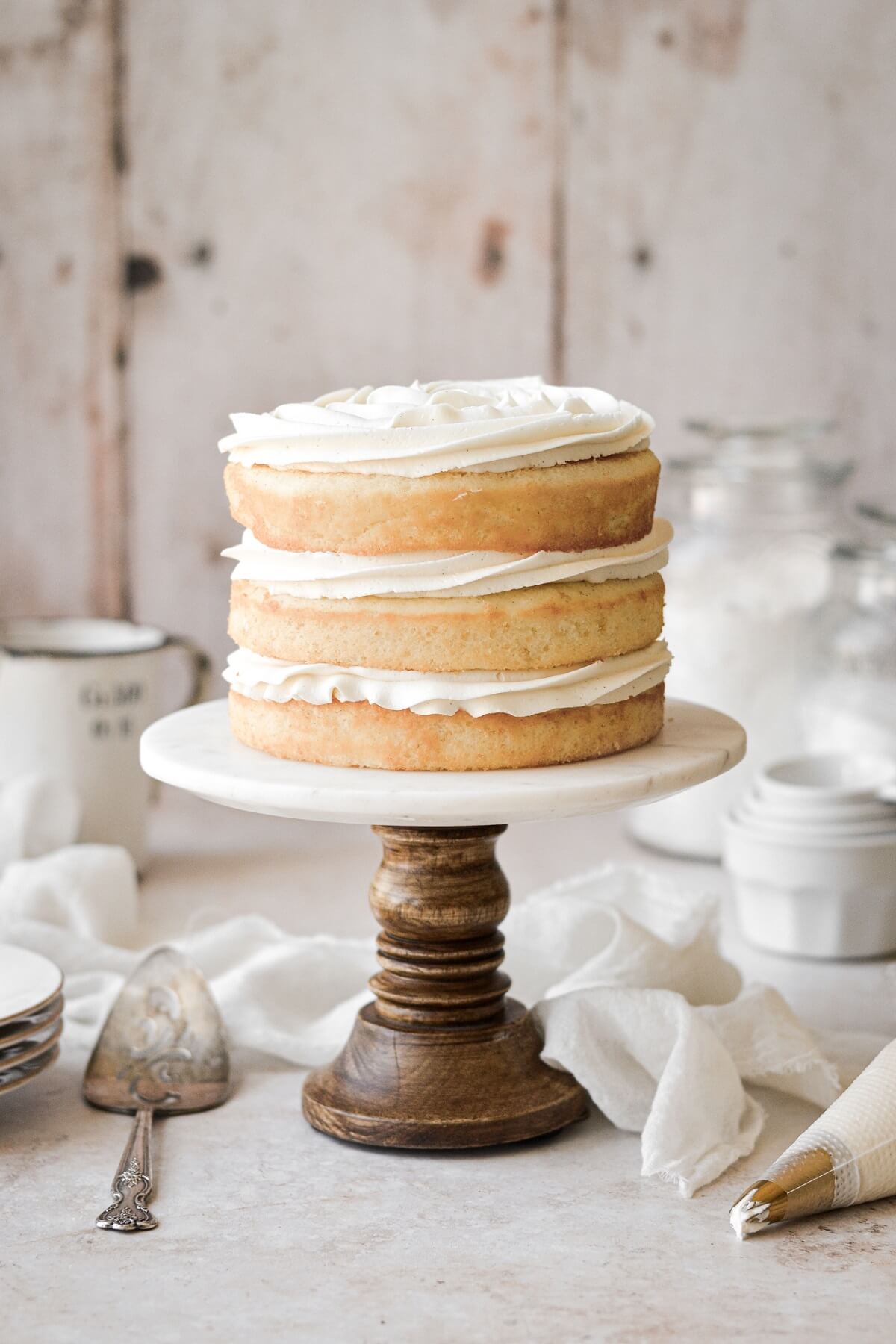
The Problem with Most Buttercream Recipes
As my blog took shape over the years, it became clear that high altitude baking was most definitely the niche that I was meant to focus on. Muffins, cookies, ice cream, and especially cakes were just so fun to make and photograph. And while my cakes tasted delicious, my buttercream was just never right. I struggled with consistency and texture, and it always seemed too sweet to me.
When I tried recipes I found online, each one was worse than the last. So many recipes claimed to be the best buttercream frosting. But they all had the same issue in that they were too sweet. Besides being tooth-achingly sweet, they were either dry and crumbly, or so soft and soupy that the frosting couldn’t possibly hold its shape when piped. And let me tell you, it’s not easy to decorate a cake if you can’t depend on your buttercream recipe to be smooth, silky, spreadable and pipeable.
I worried that mastering buttercream was something that only professional cake decorators could get right. But I was so wrong! You can easily achieve perfect buttercream with the right combination and ratio of ingredients and the proper method of mixing.
Perfecting my Recipe
While making cream-filled doughnuts one weekend morning, I made a chocolate buttercream filling that I whipped for about five minutes. And when I saw that chocolate filling, how fluffy and soft and silky it was, it hit me. This is what my buttercream should look like.
It was suddenly clear to me what was wrong with most American buttercream recipes. The ratio of butter to sugar was completely wrong, creating a frosting that was far too sweet and far too thick. And in adding more liquid to thin it out, the frosting could no longer hold its shape, turning into a soupy mess.
I felt so strongly about the success of my new buttercream recipe, that I went back and rewrote every cake recipe on my blog. I just couldn’t bear the thought of leading anyone astray with bad or ignorant techniques. And I can say with confidence that if you use these techniques, and my ratio of ingredients, you will love the results.
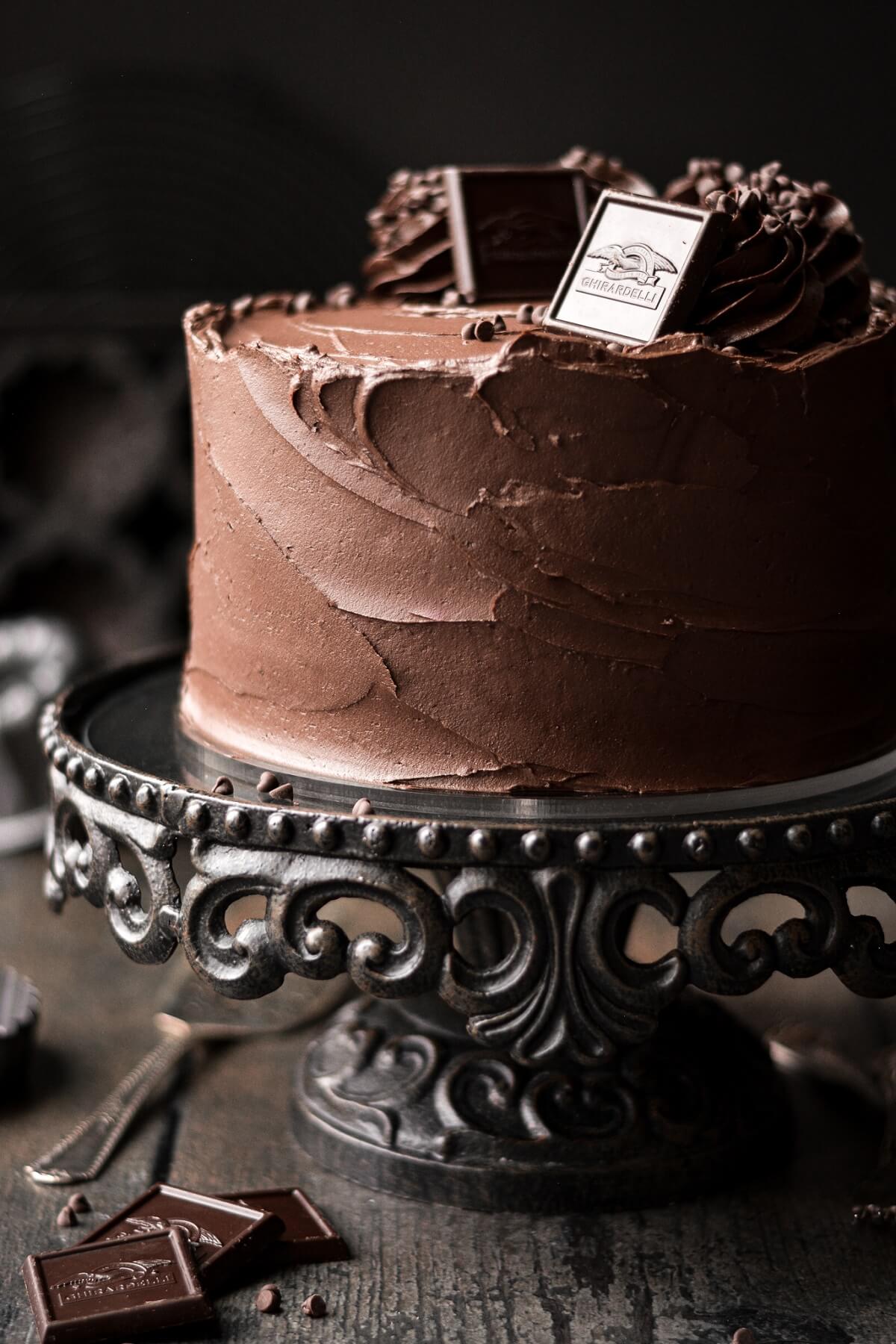
Ingredients and Tools
Butter.
- The butter is what makes buttercream rich and creamy, but also fluffy. When whipped with the powdered sugar, it lightens in color and becomes very light and fluffy. I use unsalted butter, so I can add salt as desired, but many bakers love to use salted butter for buttercream. You don’t need fancy, expensive butter, either. I usually use store-brand.
- It’s crucial that you let your butter soften to room temperature. Please don’t be led astray by recipes that tell you to only take your butter out of the fridge 20-30 minutes before you need it. Of course, you don’t want it so soft that it’s melty and greasy. This can happen in the summer or if your kitchen is very warm. But several hours at room temperature is usually necessary for butter to lose its firmness. And if your butter is still firm, your buttercream will have little lumps of butter all throughout that you will not be able to get rid of, no matter how long you whip it. In the winter, when my kitchen is chilly, I will sometimes have to soften my butter on very low power in the microwave to get it soft enough for whipping. I’ve even softened butter for a couple of minutes in my oven on the bread proof setting.
- For extra stability on a hot day, or for whiter buttercream, substitute vegetable shortening for up to 50% of the butter This is especially helpful with cream cheese buttercream, which is softer and heavier.
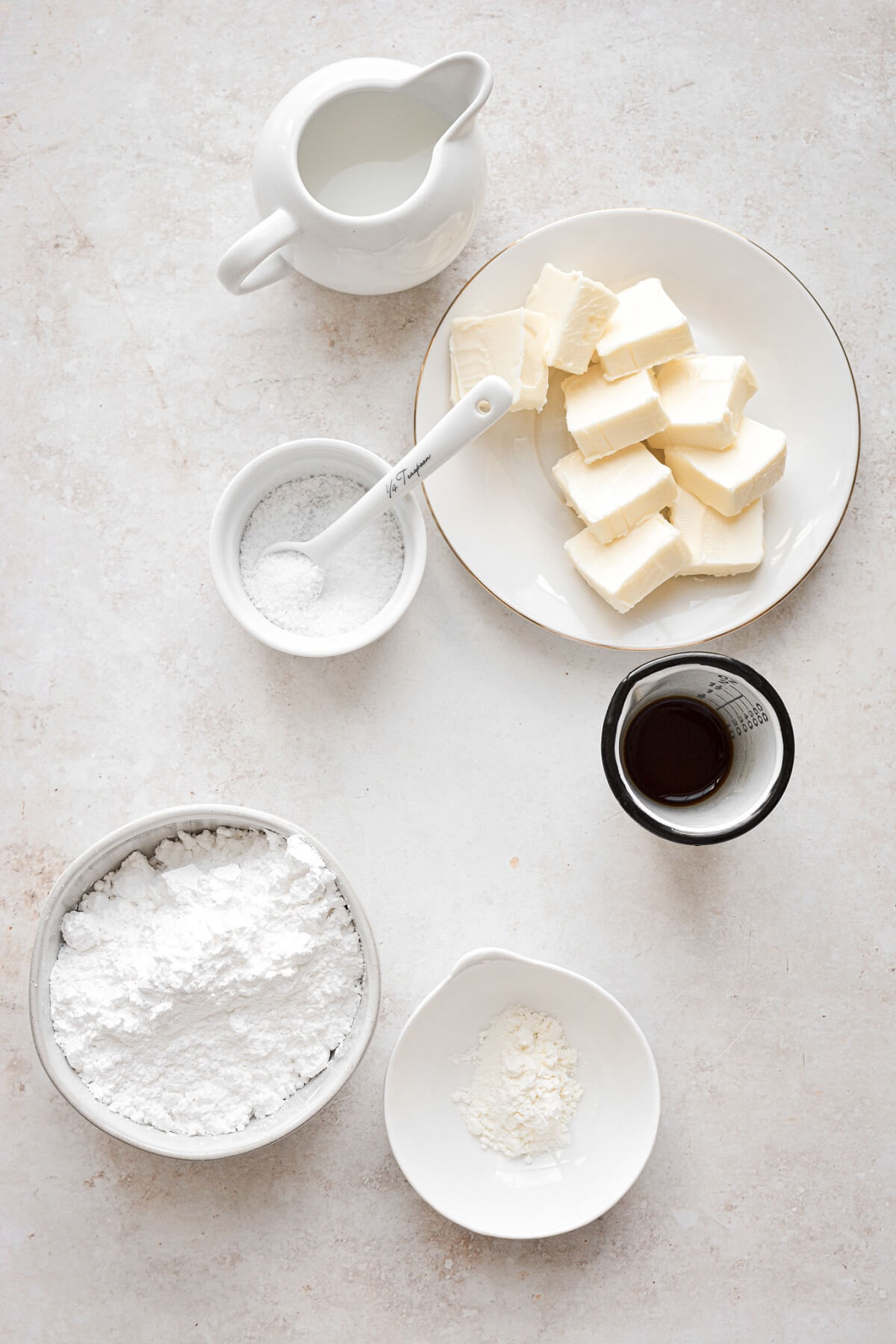
Powdered Sugar.
- Also known as confectioner’s sugar, powdered sugar sweetens and thickens the buttercream. My recipe uses about half the amount of powdered sugar that many American buttercream recipes use, so it’s the perfect balance of butter and sugar, without being excessively sweet.
- Some bakers sift their powdered sugar, but I don’t find this to be necessary. Any lumps in the powdered sugar are easily broken up when the buttercream is whipped.
Meringue Powder.
- My secret ingredient! Meringue powder is made of pasteurized egg whites that have been dried and crushed into a fine powder. It also contains some additives, such as cornstarch to absorb moisture during storage, and a few other stabilizing ingredients.
- Meringue powder adds stability to the buttercream, as well as greatly improves the texture. A tablespoon is all you need for a batch of buttercream, but you can certainly make this buttercream recipe without the meringue powder, and it will still be great.
- You can usually find meringue powder in 4 oz, 8 oz or 16 oz containers in the baking section of most craft stores, as well as online. A container of it will last a long time, and it has a long shelf life when stored in a cool dry place.
- If you’re not able to get your hands on some meringue powder, you might try a ratio of 1/4 tsp cream of tartar : 1 tsp meringue powder as a substitute stabilizing agent for your buttercream. Note that I haven’t personally tried this substitution, though, and it will probably add a tangy/tart flavor to your buttercream.
Salt.
- I love adding a pinch of coarse Kosher salt to enhance the flavors and balance the sweetness.
- If you use table salt, which has a finer grain and is saltier, you should use half the amount.
Vanilla Extract.
- Use a good-quality vanilla extract for the best flavor. Vanilla bean paste, or the seeds scraped from a real vanilla bean are excellent, too. I’ve been buying Tahitian vanilla beans online, and the flavor is wonderful. They are also very affordable.
- Of course, you can use any flavor of extract that you like in your buttercream.
- You might also like my post on How to Make Homemade Vanilla Extract.
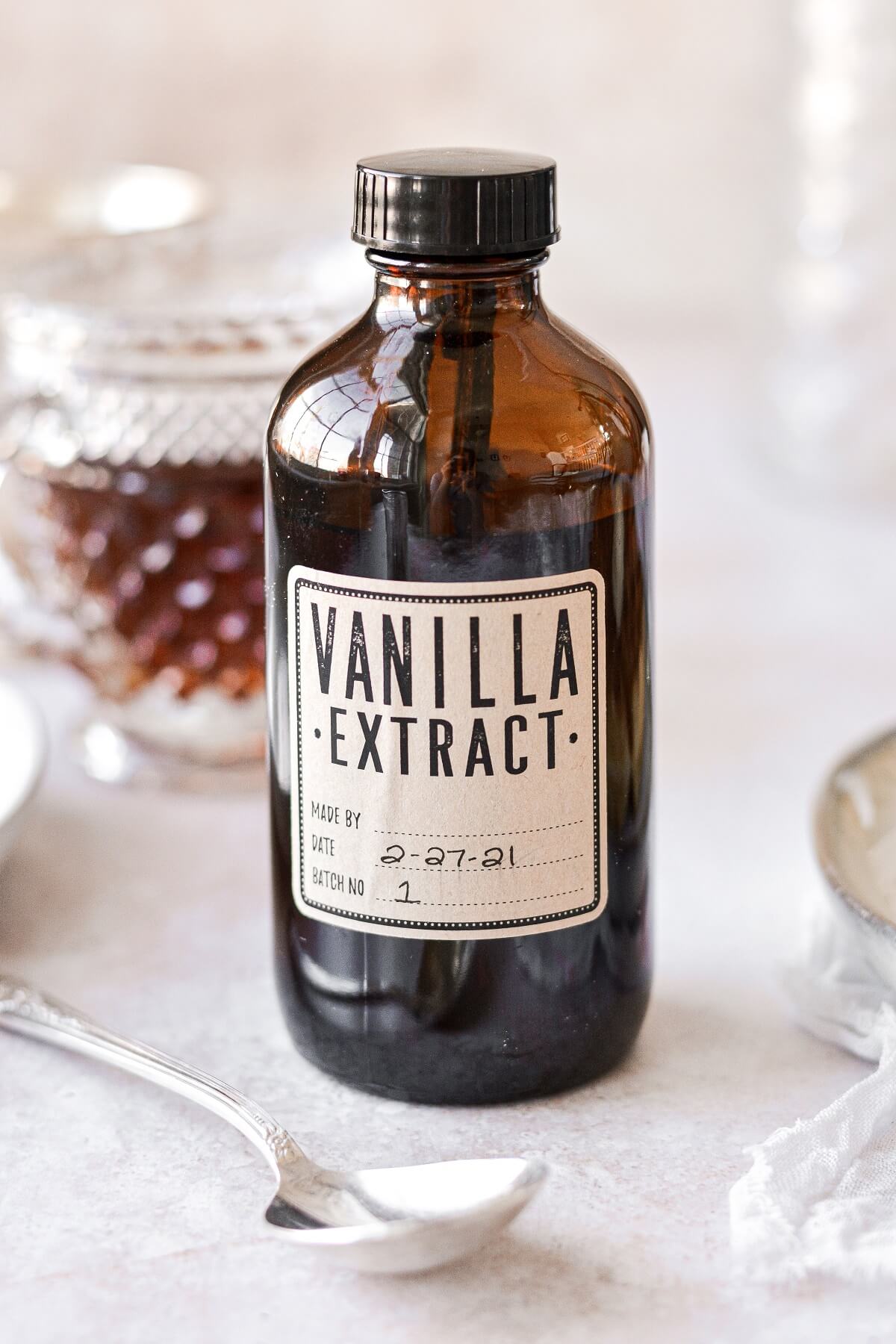
Milk.
- I only add liquid to my buttercream after I’ve combined the above ingredients, and I can see if it needs more moisture. This can often depend on the weather and time of year. Some days you’ll need more or less liquid than on other days, to get the perfect consistency for spreading and/or piping your buttercream.
- I’ll usually use whole milk, but sometimes cream or half ‘n’ half. The milk is also a placeholder for ingredients like fruit puree or jam, such as for a strawberry buttercream.
Stand Mixer.
- You need a stand mixer to make buttercream. The buttercream needs to be whipped well and fast, and a stand mixer is a necessary tool. I can’t recommend my Kitchen Aid Stand Mixer highly enough!
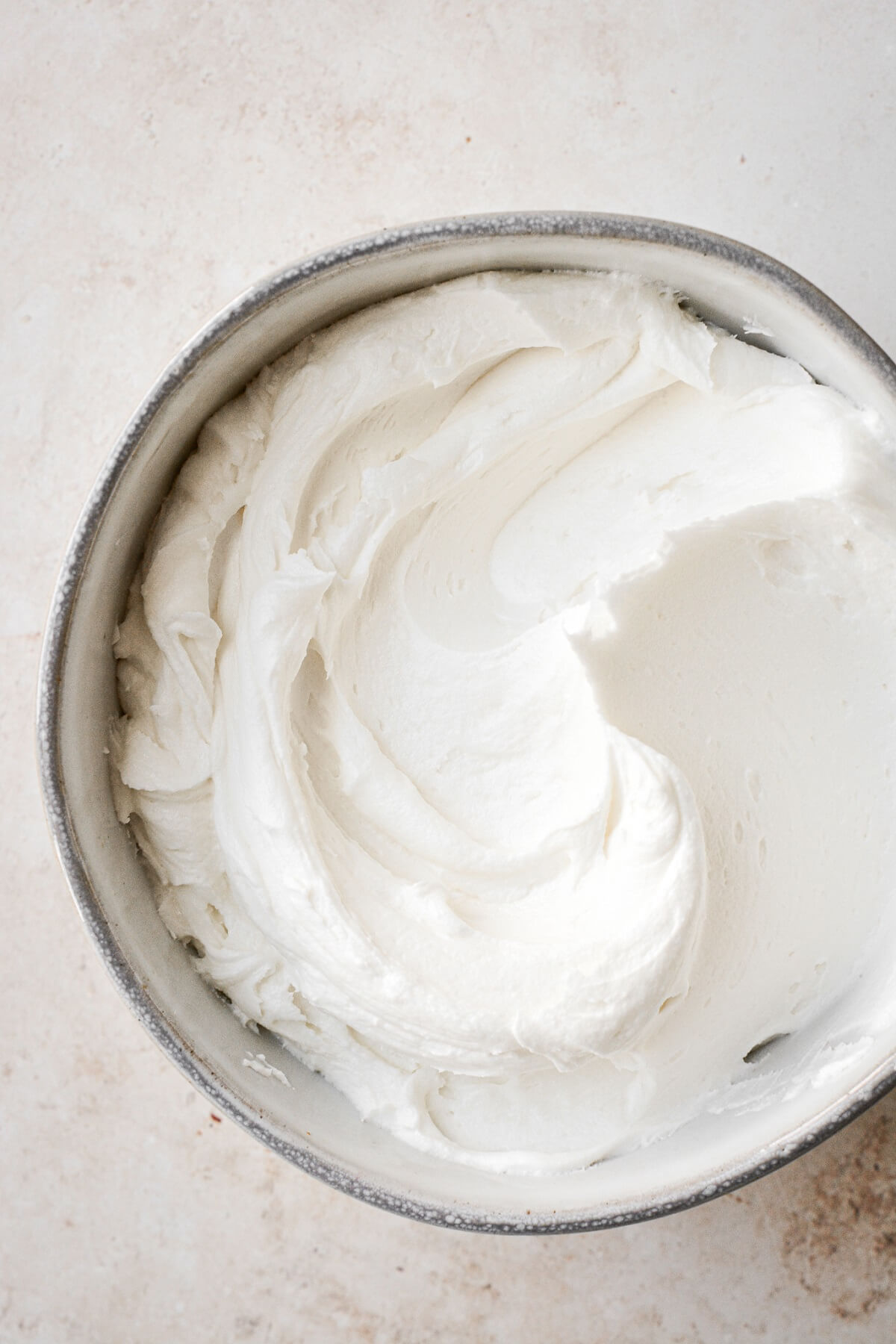
Instructions
So are you ready for the recipe? I’m so excited to share it with you. As a passionate baker, blogger and recipe developer, I love helping other bakers improve their baking skills.
My Formula
- 1/2 cup unsalted butter, softened to room temperature
- 1 cup powdered sugar
- 1 tsp meringue powder
- 1/2 tsp vanilla extract
- 1 tbsp milk (only if needed)
TIP: Scale these amounts up 2-3x for a three-layer 6-inch cake, and 3-4x for a three-layer 8-inch cake.
My Method (with step-by-step photos)
- With your stand mixer, beat the softened butter (or butter + shortening + cream cheese) for 1 minute with the paddle attachment. I used to use the whisk attachment, but I find that it whips in too many air bubbles.

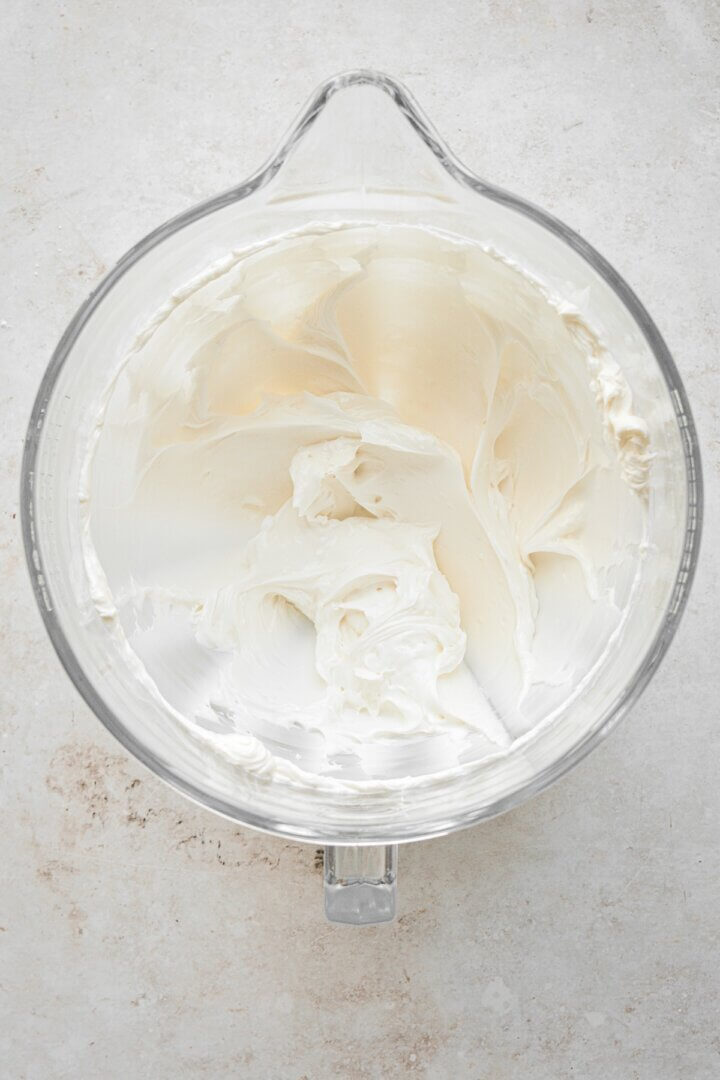
- Combine powdered sugar with meringue powder, salt, and any other dry ingredients such as spices. With the mixer running on low, add the dry ingredients to the butter by spoonfuls and mix on low to combine. It will be clumpy at this point.
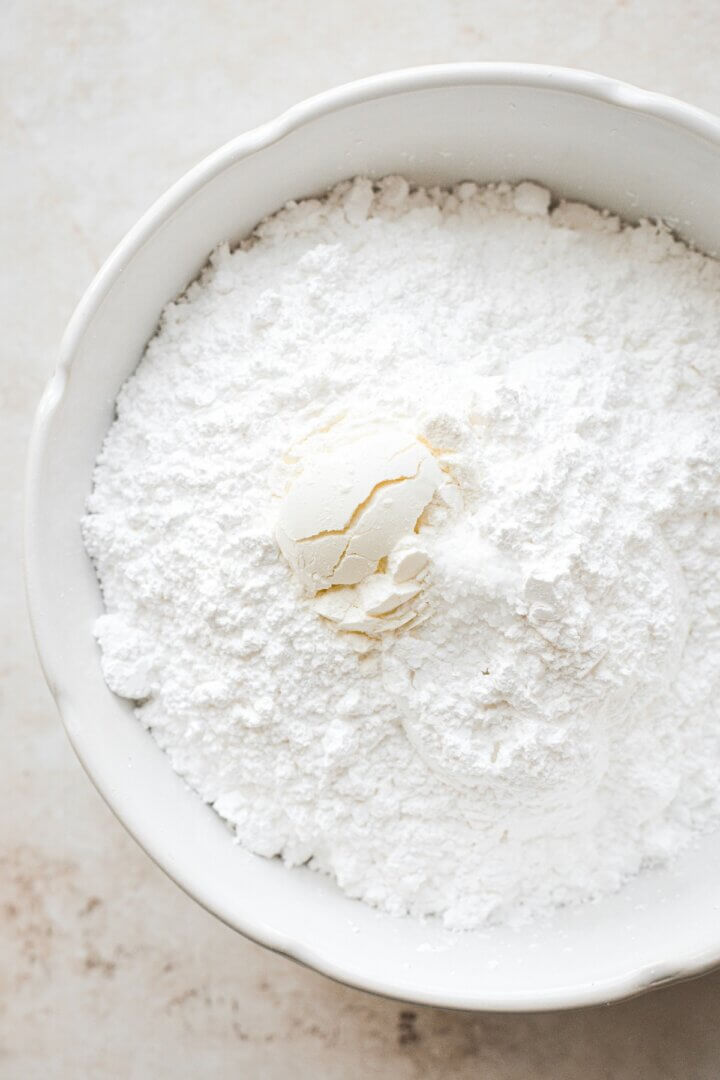
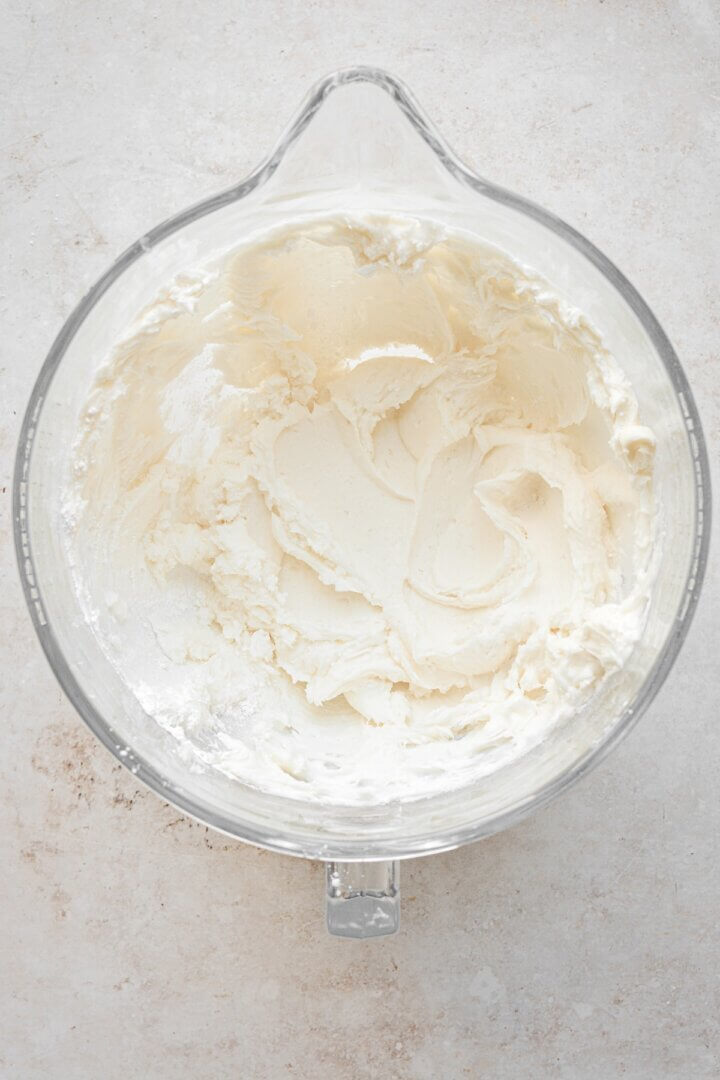
- Add the vanilla, along with any other wet ingredients you’re adding, like jam or fruit reductions or gel food coloring. Wait to add the milk until you need it for desired consistency.
- Increase speed to medium/medium-high (#4/6 on my Kitchen Aid mixer) and whip for 4-5 minutes until impossibly light and fluffy, scraping the bowl several times, and adding the milk if needed.
- Turn the mixer down to low and mix for 1 minute. This helps to eliminate some of the bigger air bubbles throughout the buttercream if you’re trying to frost your cake with a smooth finish.

- If using any add-ins, such as chopped chocolate or nuts, fold them in with a spatula after whipping the buttercream. Be careful of adding whole pieces of fruit or anything that contains water. Wet fruit will dissolve the sugar and turn the buttercream too liquidy.
- Your buttercream is now ready for spreading or piping. It should be fluffy and able to hold its shape when piped, without being stiff, dry or crumbly.
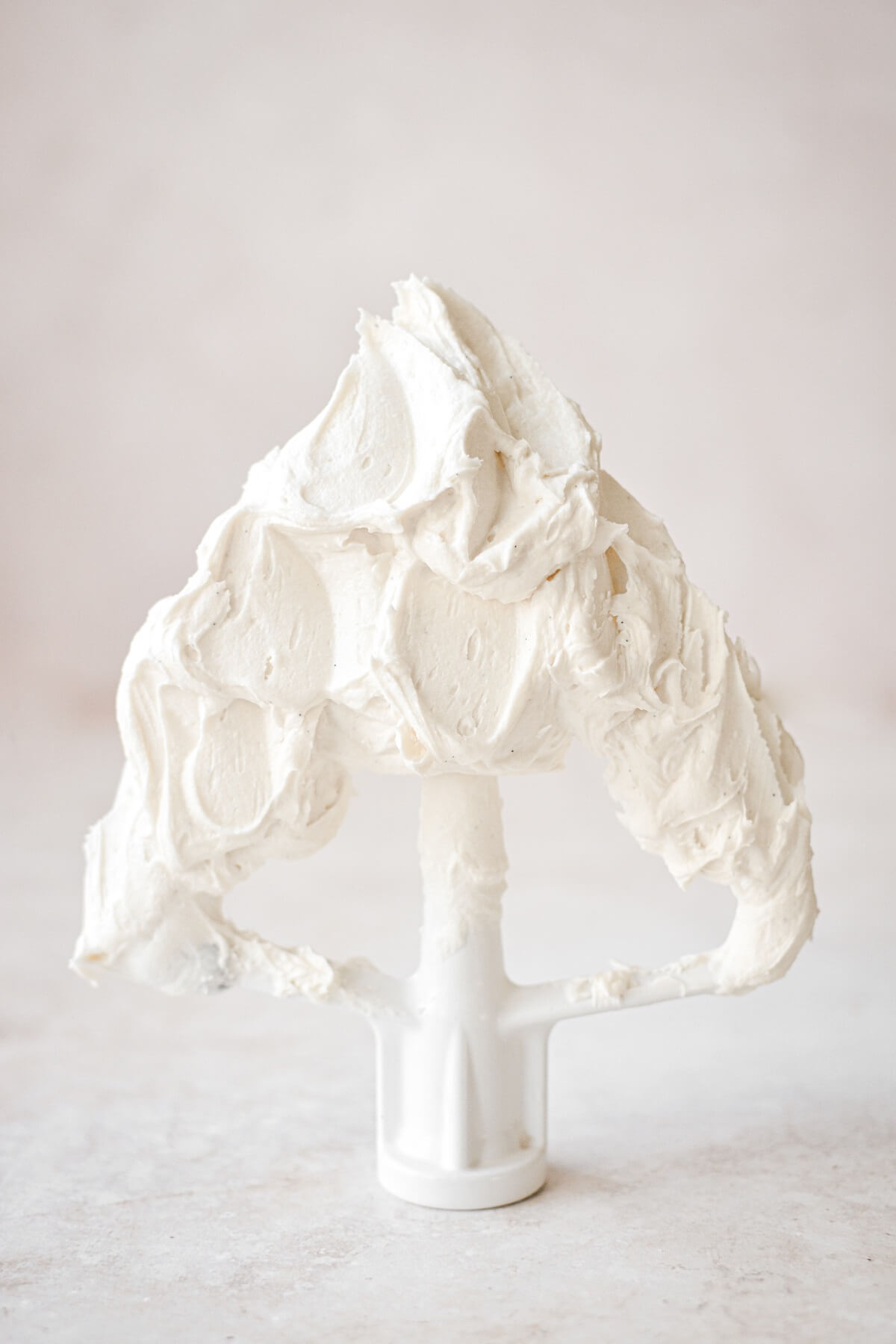
Buttercream Flavor Variations
Chocolate Buttercream
- Replace 1/4 – 1/3 of the powdered sugar with the same amount of unsweetened cocoa powder (preferably Dutch processed).
Coffee Buttercream
- Add 1-2 teaspoons espresso powder per each 1/2 cup of butter, or as much as you like for the strength of the coffee flavor. To extract the most flavor from the espresso powder, dissolve the espresso powder in a small amount of milk or cream before adding to the buttercream.
Mint Buttercream
- For anything peppermint flavored, or for mint chocolate chip frosting, add peppermint extract to taste. Don’t use mint extract, which can have a spearmint flavor.
Fruit Buttercream (Strawberry, Raspberry, etc.)
- The fruit must be reduced, or the water content will dissolve the sugar, and the frosting will never get thick and fluffy.
- For frosting a whole cake (3x the recipe), combine 1 cup sliced/chopped berries with 1/4 cup granulated sugar. Let macerate for 1 hour.
- Puree in blender until smooth, then strain out and discard the seeds.
- Pour liquid into a small saucepan and reduce over medium low until thick and syrupy – reduce to 1/4 cup. Chill completely.
- Beat in with the butter instead of the milk.
- Alternatively, just add a good-quality jam (preferably seedless) to your buttercream instead of homemade fruit puree.
- You can also try adding freeze dried strawberries/blueberries/raspberries, crushed into a powder, then whipped into your buttercream.
Lemon or Lime Buttercream
- Add 1-2 tablespoons lemon or lime curd per stick of butter, plus freshly grated lemon or lime zest, and lemon extract if desired. Reduce the milk slightly.
- Proceed with caution when adding fresh lemon or lime juice to your buttercream. The acid has the tendency to curdle the buttercream, and it can’t be saved if that happens.
Orange Buttercream.
- Add 1-2 teaspoons freshly grated orange zest to your buttercream. Too much orange zest can add a bitter flavor, though.
- Add a small amount (1/4 – 1 teaspoon) orange extract. Too much orange extract can taste artificial, with an almost burning sensation on your tongue, so add less to start, and more as needed to taste.
Peanut Butter Buttercream
- Add 3-4 tablespoons creamy (no stir) peanut butter, for every 1/2 cup of butter.
- I’ve found that whipping the peanut butter for a long time can dry it out and make your buttercream crumbly. It works much better to fold the peanut butter in after you’ve whipped the butter and powdered sugar.
- This will also work with Biscoff spread (cookie butter spread), Nutella (chocolate hazelnut spread) or other types of nut butters.
- Avoid using all-natural nut butters that separate and need to be stirred, as the oil can make your buttercream runny and unstable.
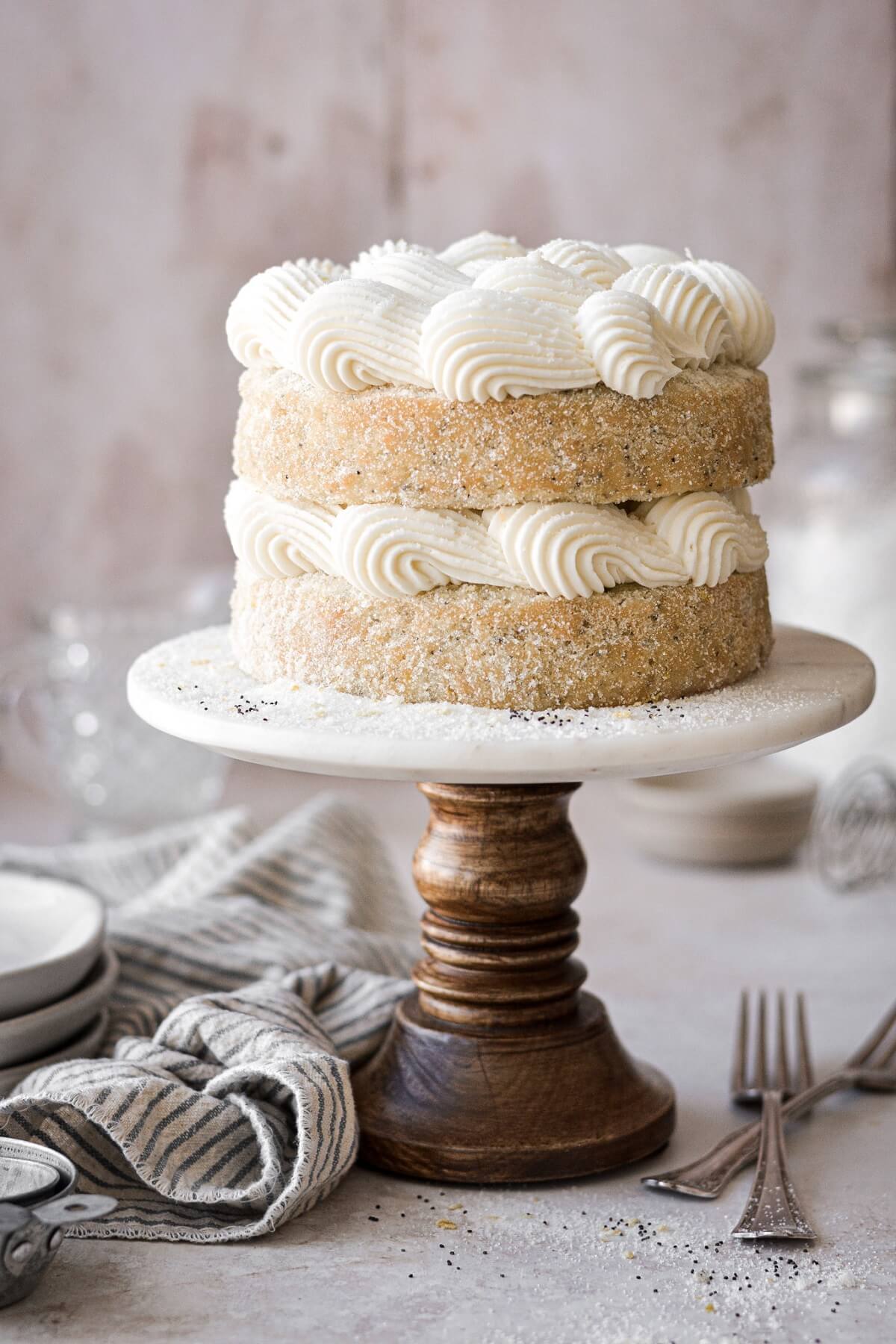
Cream Cheese Buttercream
- Cream cheese frosting for layer cakes can be tricky. It’s softer and heavier than regular buttercream, but you CAN master cream cheese buttercream.
- For frosting a layer cake or piping onto cupcakes where a fluffier consistency that can hold its shape is needed, you must use half cream cheese + half butter/half shortening, using the formula above, although extra powdered sugar may be needed.
- Remember that one 8-ounce package of block cream cheese is equal to 1 cup (2 sticks) of butter.
- While the butter should be softened to room temperature, your cream cheese should be cold from the fridge, which helps with stability while you’re frosting your cake or piping the buttercream.
- To frost a three-layer 8-inch cake, I will use 1 package (8 ounces) cream cheese, 1/2 cup butter, 1/2 cup shortening, 5 cups powdered sugar, 1 tablespoon meringue powder, and 2 teaspoons vanilla. This makes a beautiful buttercream that can be spread and piped onto layer cakes without losing its shape or sliding off. I almost never need to add milk to cream cheese buttercream, except for when my kitchen is really cold in the winter.
- 2/23/23 Update: I’ve also begun experimenting with adding 1-2 tablespoons of corn starch to my cream cheese buttercream. It helps to stabilize and thicken the buttercream, especially in warmer weather, without affecting the taste. (The above photo shows lemon cream cheese buttercream piped onto naked lemon poppy seed cake layers. The photo below shows a carrot cake with cream cheese buttercream.)

Frequently Asked Questions
How much buttercream does this recipe make?
- This makes 1 1/4 cups of buttercream, which is enough to frost 8-10 cupcakes or a single layer of cake.
- The recipe needs to be multiplied by 3x or 4x to have enough to frost a 2-3 layer cake or 24 cupcakes, depending on how much you like to use. For elaborate piping all over an 8-inch 3-layer cake, I will always multiply this recipe by 4x to ensure I have enough, and then freeze any leftover buttercream.
How do I store extra buttercream?
- It’s better to have too much buttercream for a project than too little, so don’t be worried if you have some leftover.
- You can refrigerate leftover buttercream for about 1 week, or store it in a labeled freezer bag for 3-6 months. After thawing it out, you may need to re-whip it for a minute or two to bring it back together.
Is this buttercream best for piping or spreading onto cakes?
- My American buttercream is perfect for both spreading and piping onto cakes!
- Remember that you’ll use more buttercream if you’re piping it onto a cake or cupcakes, than if you’re spreading it on with an icing spatula.
Should I ever adjust the ratio of ingredients in this recipe?
- Understand that these ratios are a guideline, and may vary slightly depending on certain factors. For example, one day you may need an extra half cup of powdered sugar, because you added strawberry jam to the buttercream.
- Cream cheese is softer than butter, and it takes more powdered sugar to reach the right consistency for cream cheese buttercreams.
- But in general, these ratios shouldn’t vary a whole lot. I have found that by sticking to this formula, I’m never disappointed in the result.
What does salt do in buttercream?
- Salt balances sugar, and enhances flavor, so I almost always add a pinch of salt to my buttercream. It’s especially good in something like butter pecan buttercream.
- About 1/4 teaspoon of coarse Kosher salt for 3-4x the buttercream formula is plenty. If you use table salt, which has a finer grain and is saltier, you should use half the amount.
How do you make a really white buttercream?
- Whipping the buttercream not only makes it light and fluffy, but also lightens the color of the butter to a paler shade of yellow. But all-butter buttercream will always be an off-white color, never pure white.
- If you’d like a really white buttercream, then substitute half the butter with shortening. Using half butter and half shortening also makes a very stable buttercream for a cake that’s going to be sitting out in warmer weather.
- You can also add a few drops of “bright white” gel food coloring, which works very well to neutralize the yellow color of the butter and whiten the buttercream.
- Keep in mind that different brands of butter vary in their “yellowness”. The more yellow the butter, the more yellow your buttercream will be. European butters tend to be much more yellow than store brands.
How do I make brown butter buttercream?
- Brown butter is fabulous in buttercream with its rich, nutty flavor. The process of browning butter is simple. You melt the butter in a saucepan on your stove, over medium heat. After the butter melts, continue to cook the butter, swirling the pan occasionally. It will hiss and spatter as the water evaporates, while the milk solids collect on the bottom of the pan, turning fragrant and golden brown. When the butter is nearly ready, the hissing will quiet down, and a layer of foam will form on the surface; this is your clue that it’s done. Don’t leave the pan on the heat too long, or the butter will burn.
- Immediately remove the butter from the heat, and use a spatula to scrape up all the brown solids on the bottom of the pan. Pour the butter into a bowl, and let it cool at room temperature for several hours until it becomes someone solid again, and is soft and spreadable.
- You can now proceed with whipping your buttercream. Note that you’ll lose a few tablespoons of butter, so you’ll need slightly less powdered sugar. Browned butter is also drier, since all the water evaporates during the browning process, so you’ll probably need to add a little more milk to your buttercream, or it will be crumbly.
- If you’re browning 1/2 cup (4 ounces) of butter, this process might only take 5 minutes. For a full pound of butter, it might take up to 10-15 minutes to brown.
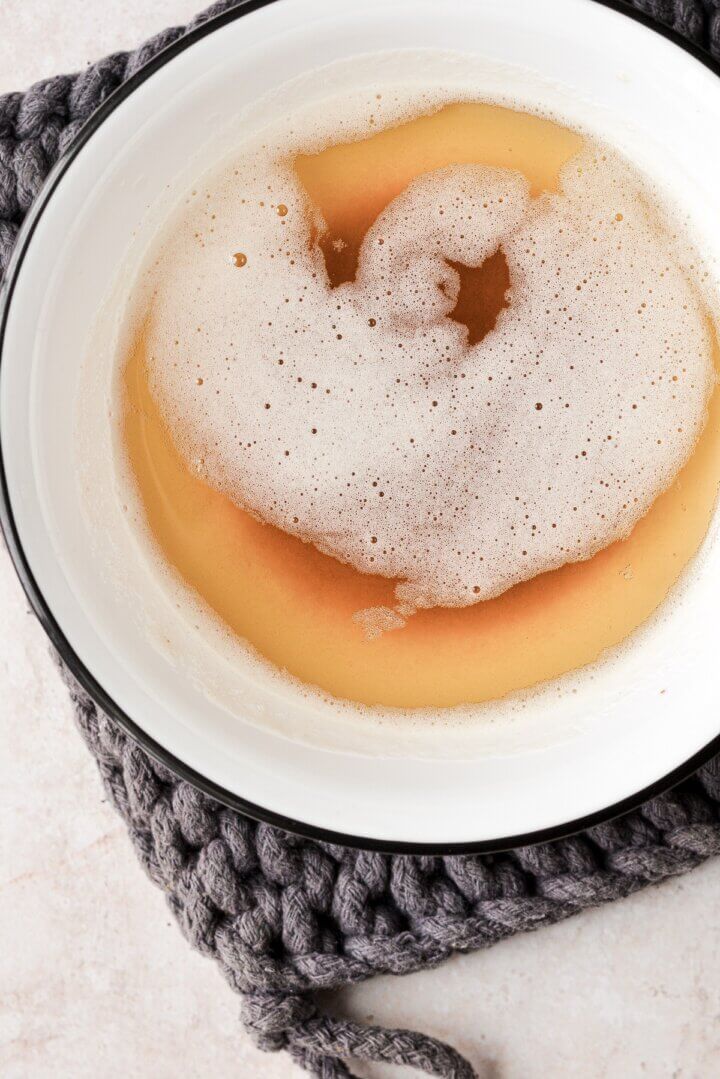
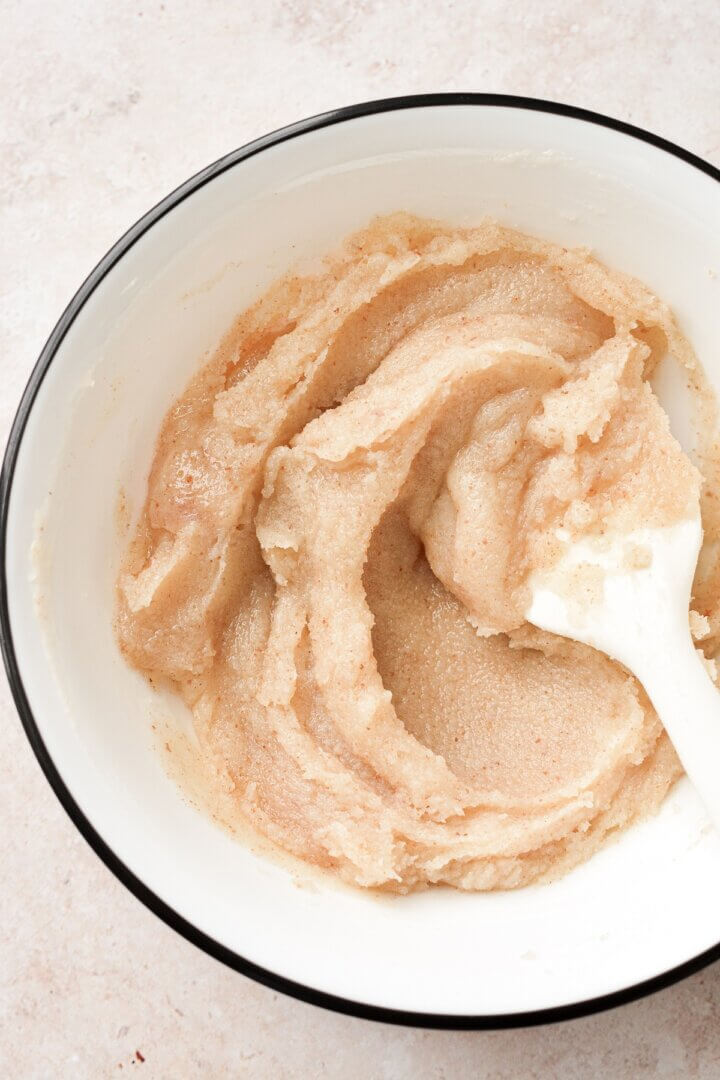
What does the milk do in buttercream?
- Only use the milk as needed, if the buttercream is too thick and needs to be thinned out to your desired consistency for spreading and piping.
- The milk also serves as a “placeholder” for other things you might like to add, such as concentrated syrups, like a champagne reduction, or fruit jams and reductions. If using these sorts of flavor additions, they take the place of the milk, although you may still need a little milk.
- Sometimes I don’t use the milk at all if my kitchen is extremely warm and the butter is very soft. Use your judgement.
Is American buttercream a crusting buttercream?
- Yes, American buttercream frosting is a “crusting” buttercream. This means that after frosting your cake, the surface will slightly dry or crust over, while remaining soft underneath. Unlike Swiss or Italian meringue buttercreams, which do not crust over.
- This happens in about 30 minutes to an hour, and can be sped up by chilling the cake. Chilling your cake is desirable when you’ve frosted your cake with a crumb coat, and need that to dry and chill before adding your final pretty coat of buttercream.
- When decorating with things like sugar pearls or sprinkles, you want to add those to your cake before the frosting crusts over. When adding decorative piping (such as all-over rosettes), or “painting” onto your cake with more buttercream, do this after the frosting crusts over.
Do buttercream frosted cakes need to be refrigerated?
- Most of the time, no, cakes frosted in buttercream don’t need to be refrigerated. They are perfectly fine stored at room temperature in an airtight container for 3-4 days.
- Even though buttercream contains butter and a small amount of milk, the large amount of sugar stabilizes the milk solids so they don’t spoil.
- For cakes frosted with cream cheese buttercream, I do store the leftovers in the refrigerator overnight. Then let the cake sit out to come to room temperature again before serving.
- In extremely hot weather, cakes do need to be refrigerated, or the buttercream will become too soft and your cake can slide apart into a complete mess. I’m talking about 90 degree days and up, where even having the AC turned to 74 degrees won’t keep my kitchen cool enough for a cake. On days like this, I will always keep a cake chilled, then let it warm up to room temperature for 3-4 hours before serving. And don’t even think about displaying a cake outside on a hot day.
What can I use as a substitute for the meringue powder?
- Meringue powder is made of pasteurized egg whites that have been dried and crushed into a fine powder. It also contains some additives, such as cornstarch to absorb moisture during storage, and a few other stabilizing ingredients. I use it in many recipes on my site, mostly in buttercream, in glazes for loaf cakes, and in icings for cookies.
- Meringue powder adds stability to the buttercream, as well as greatly improves the texture. A tablespoon is all you need for a batch of buttercream (one “batch” being 3-4x the recipe in the recipe card below), but you can certainly make this buttercream recipe without the meringue powder, and it will still be great.
- You can usually find meringue powder in 4 oz, 8 oz or 16 oz containers in the baking section of most craft stores, as well as online. A container of it will last a long time, and it has a long shelf life when stored in a cool dry place.
- If you’re not able to get your hands on some meringue powder, you might try a ratio of 1/4 tsp cream of tartar : 1 tsp meringue powder as a substitute stabilizing agent for your buttercream. Note that I haven’t personally tried this substitution, though, and it will likely add a tangy/tart flavor to your buttercream.
Do you have a recipe for whipped cream frosting?
Yes, I do! My whipped cream frosting is lightly sweetened, and I always use either cream cheese or mascarpone cheese to stabilize it, so it doesn’t deflate on the cake. You can find my recipe for whipped cream frosting in this post for limoncello cream cake and blueberry jam and cream cake.
Other Resources
For more tips, be sure to read my post on How to Stack, Fill, Crumb Coat and Frost a Layer Cake.
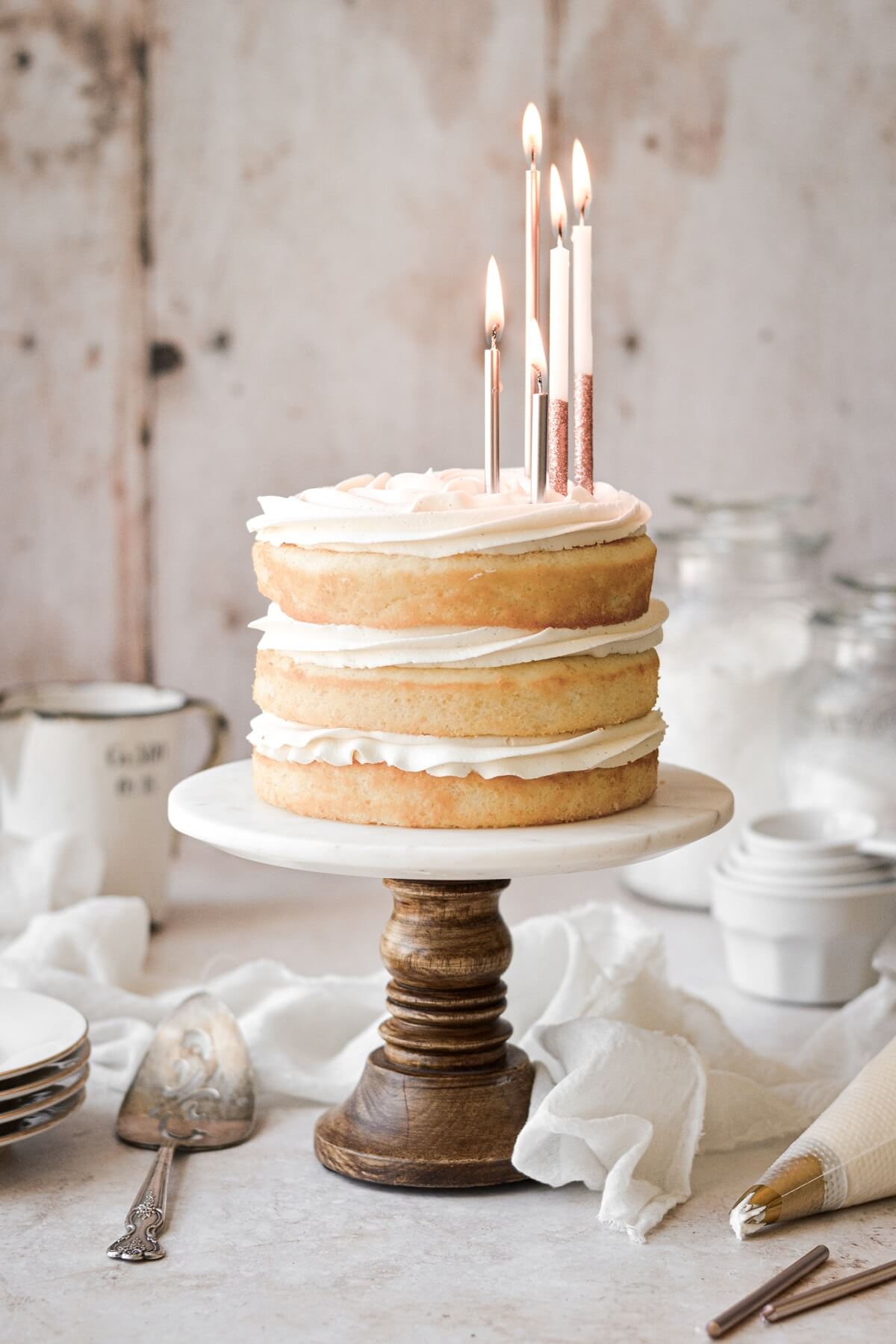
You Might Also Like
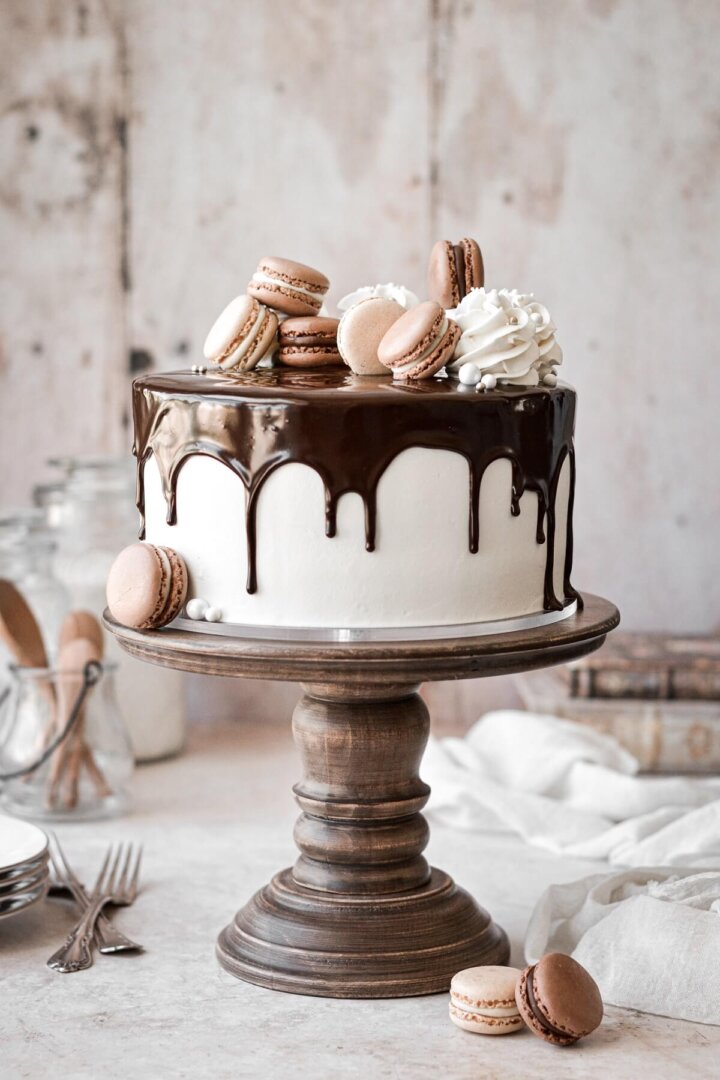
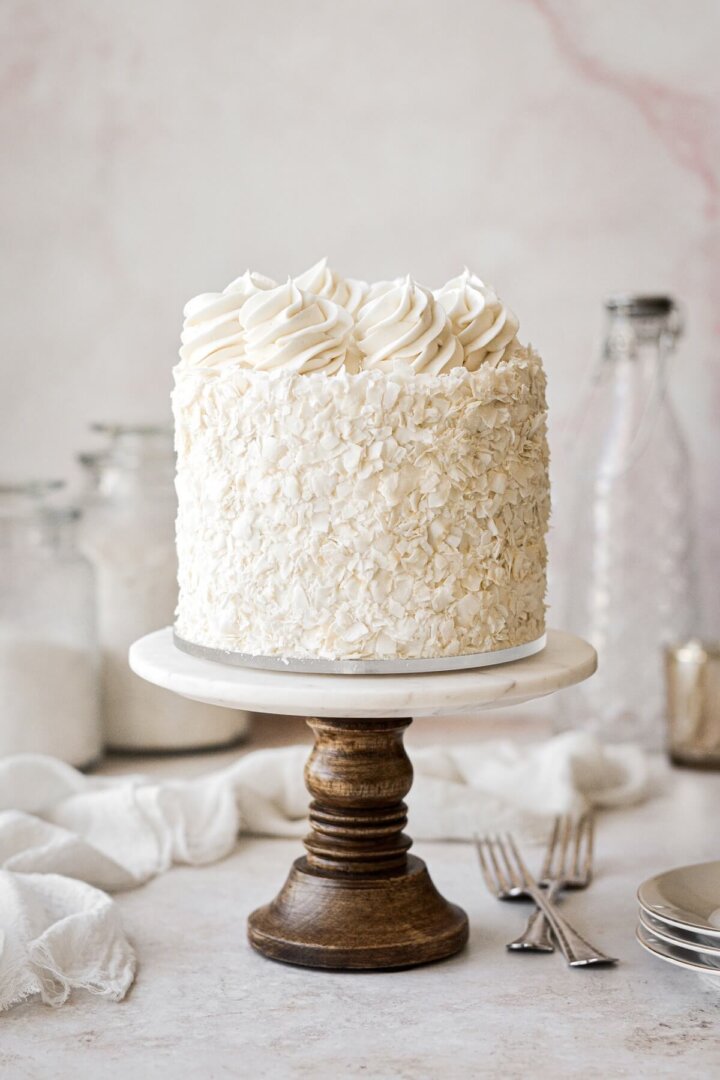
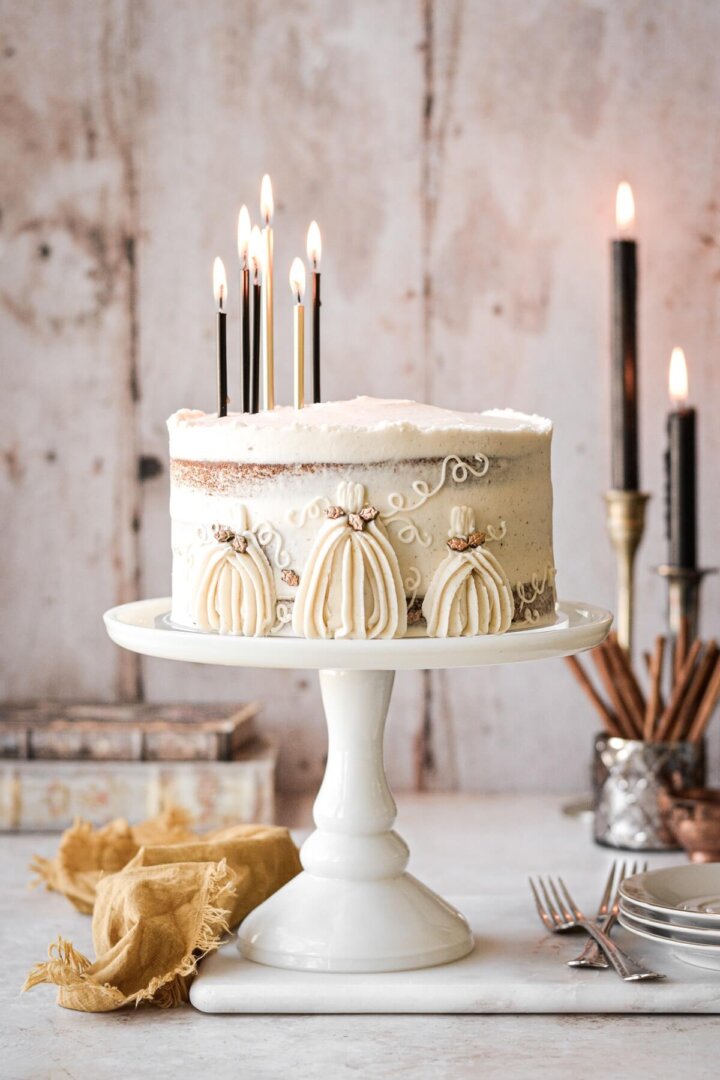
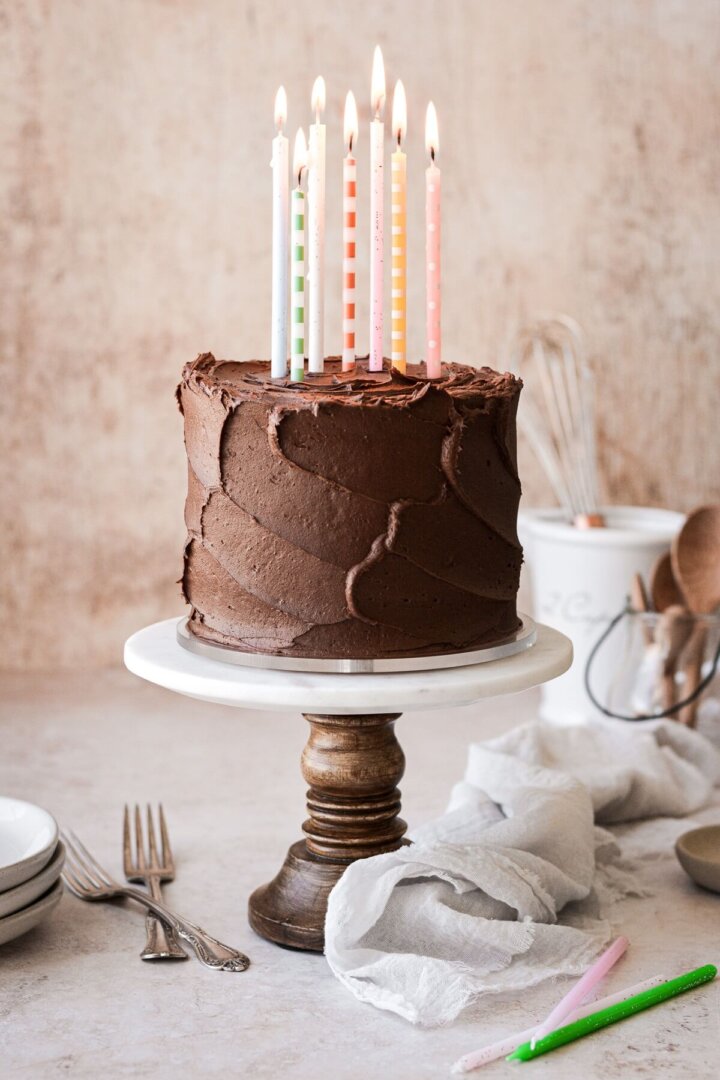
Please check out my Amazon Shop for a curated collection of some of my favorite cake pans from trusted brands, baking tools, ingredients, pretty things and fashion finds. I recommend products that I buy and use every day!
Did you love today’s recipe? Please rate the recipe and let me know in the comments what you thought! Also, be sure to follow Curly Girl Kitchen on Instagram, and tag me when you try one of my recipes so I can see all your delicious creations!

Perfect American Buttercream Frosting
All recipes on Curly Girl Kitchen are developed for high altitude at 5,280 feet. See FAQs for adjusting to higher or lower elevations.
Equipment
- Stand Mixer with Paddle Attachment
Ingredients
- ½ cup (113g) unsalted butter, softened to room temperature
- 1 cup (140g) powdered sugar
- 1 tsp (3g) meringue powder (optional, but it adds stability)
- ½ tsp (2g) vanilla extract
- 1 tbsp (16g) whole milk
Instructions
- With your stand mixer, beat the softened butter for 1 minute with the paddle attachment.
- Combine the powdered sugar with meringue powder, salt, and any other dry ingredients you might be using. With the mixer running on low, add the dry ingredients to the butter by spoonfuls and mix on low to combine. It will be clumpy at this point.
- Add vanilla, along with any other wet ingredients you're adding, like jam or fruit reductions or gel food coloring. Wait to add the milk until you need it for desired consistency.
- Increase speed to medium high and whip for 4-5 minutes until impossibly light and fluffy, scraping the bowl several times, and adding the milk if needed. Turn the mixer down to low and mix for 1 minute – this helps to eliminate some of the bigger air bubbles throughout the buttercream if you're trying to frost your cake with a smooth finish.
- If using any add-ins, such as chopped chocolate or nuts, fold them in with a spatula after whipping the buttercream. Be careful of adding whole pieces of fruit or anything that contains water, as it will dissolve the sugar and turn the buttercream too liquidy.
Notes
- This makes 1 1/4 cups of buttercream, which is enough to frost 8-10 cupcakes or a single layer of cake.
- The recipe needs to be multiplied by 3x or 4x to have enough to frost a 2-3 layer cake or 24 cupcakes, depending on how much you like to use. For elaborate piping all over an 8-inch 3-layer cake, I will always multiply this recipe by 4x to ensure I have enough, and then freeze any leftover buttercream.
- Remember that you’ll use more buttercream if you’re piping it onto a cake or cupcakes, than if you’re spreading it on with an icing spatula.
- Understand that these ratios are a guideline, and may vary slightly depending on certain factors; for example, one day you may need an extra half cup of powdered sugar, because you added strawberry jam to the buttercream.
- Cream cheese, also, is softer than butter, and it takes more powdered sugar to reach the right consistency for cream cheese buttercreams.
- But in general, these ratios shouldn’t vary a whole lot. I have found that by sticking to this formula, I’m never disappointed in the result.
- I also usually add a pinch of salt as well, which is a nice complement to sweet buttercream, especially if you’re using nuts like in a butter pecan buttercream. About 1/4 teaspoon of coarse Kosher salt for 3x the buttercream formula is plenty.
- Whipping the buttercream not only makes it light and fluffy, but also lightens the color of the butter to a paler shade of yellow, but all-butter buttercream will always be an off-white color, never pure white.
- If you’d like a really white buttercream, then substitute half the butter with shortening (using half butter and half shortening also makes a very stable buttercream for a cake that’s going to be sitting out in warmer weather).
- The milk or cream also serves as a “placeholder” for other things you might like to add, such as concentrated syrups, like a champagne reduction, or fruit reductions, etc. If using these sorts of flavor additions, they take the place of the milk, although a little milk may still be needed. Sometimes I don’t use the milk at all if my kitchen is extremely warm and the butter is very soft – use your judgement.
- It’s always better to have too much buttercream than too little, and leftover buttercream freezes really well for other projects.
- Also note that American buttercream is a “crusting” buttercream. This means that after frosting your cake, the surface will slightly dry or crust over, while remaining soft underneath (unlike Swiss or Italian meringue buttercreams, which do not crust over).
- This happens in about 30 minutes to an hour, and can be sped up by chilling the cake, which is desirable when you’ve frosted your cake with a crumb coat, and need that to dry and chill before adding your final pretty coat of buttercream.
- When decorating with things like sugar pearls or sprinkles, you want to add those to your cake before the frosting crusts over. When adding decorative piping (such as all-over rosettes), or “painting” onto your cake with more buttercream, do this after the frosting crusts over.
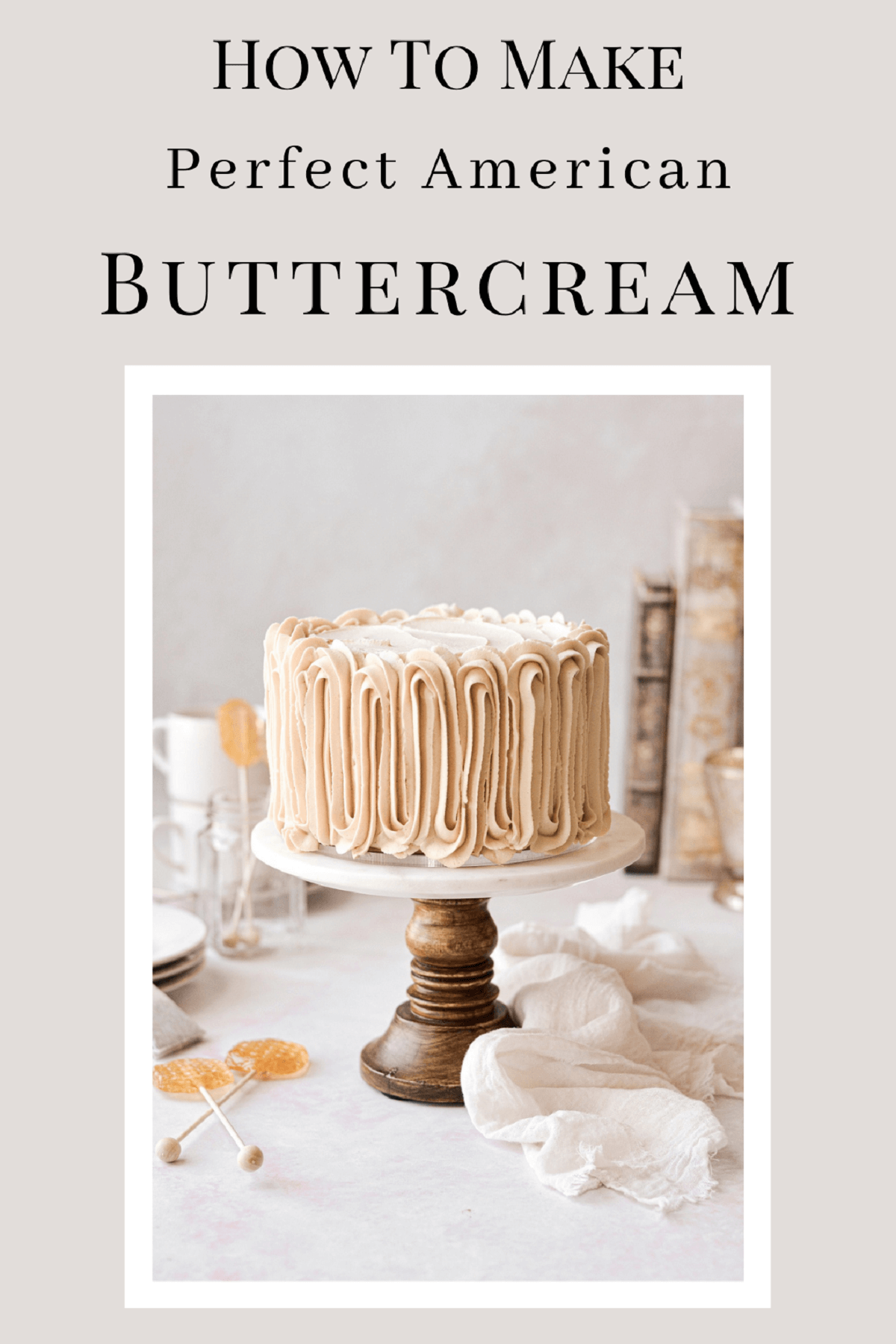

It has taken years to find a buttercream that not only tastes great but stands up to the Florida heat and humidity. This recipe is outstanding. Thank you so much for sharing. 🙂
I like this recipe it’s not too sweet. Holds up to this Florida humidity!
Hi! Love your information and thank you for sharing it! Question, what if you do not have a stand mixer, can you still make this buttercream icing?
You can use a hand held electric mixer, but it’ll be more challenging, especially for larger batches of buttercream.
Hi I usually make Swiss Meringue buttercream but I want to try the much more stiffness and stable American buttercream to pipe floral designs. Is this stable to pipe intricate designs and is this smoother without bubbles?
This is a very stable buttercream for piping. To eliminate air bubbles, I mix the buttercream on “stir” for 1-2 minutes at the end. If it still has bubbles, you can press them out by pressing the buttercream against the side of your mixing bowl with a spatula. Often, it’s easier to eliminate any bubbles in leftover buttercream. So you can always make it a few days in advance, then stir it to press out the bubbles.
Love this buttercream! Can I add cocoa to this to make chocolate buttercream?
Yes, that’s included in the variations I have in this post.
Love this buttercream recipe perfect and not too sweet. I will be using this recipe for my daughter in law bridal shower cupcakes. I used half butter and sweetex high ratio shortening and it came out perfect.
Hi, Can I use corn starch as a substitute for the meringue powder?
Probably! I have started adding a small amount of corn starch to my cream cheese buttercream to help thicken and stabilize it. But I haven’t tried it as a replacement for the meringue powder. Please let me know if you do!
I had all the icing issues you outline in this post.
I tried your recipe and my icing is perfection now!!!!!
Thank you!!!
Omg is all I can say. I live in Albuquerque New Mexico and normally do a Swiss meringue buttercream because all of the American buttercream’s are too sweet. This was absolutely amazing. I usually make small batch cupcakes or 6 inch cake is the perfect amount
Love the “just the right amount of sweetness!” Quick question: The meringue powder- do I add water to it or just use it as the powder?
Thank you
You don’t add water to it.
Hi if I want to colour the cake for a kids birthday party – if it’s liquid do I take that out of the milk content?? Thanks
In your description you said 1 TBL of meringue powder, in your recipe it’s 1 teaspoon. What should it be? Thank you so much.
It’s 1 teaspoon.
Absolutely love this recipe! Perfect buttercream! Wondering if it can be adapted to white chocolate though?
So glad you love it! Here’s my white chocolate buttercream recipe: https://curlygirlkitchen.com/white-chocolate-cake-ganache-drip-truffles/
Hands down the best buttercream frosting! It’s light, fluffy, has the perfect amount of sweetness, and is amazing to frost and/or pipe with. Thank you!